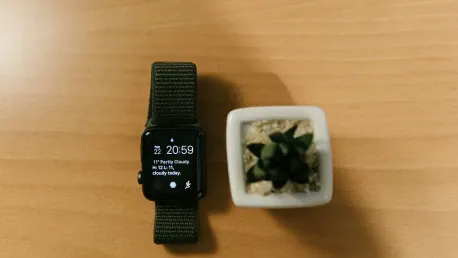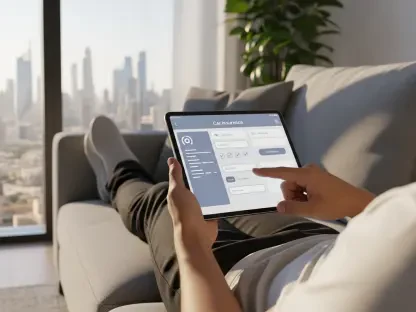The recent development at Northwestern University has resulted in the creation of a groundbreaking wearable device designed to measure gases emitted from and absorbed by the skin. This innovation, spearheaded by researchers John A. Rogers and Guillermo A. Ameer, represents a significant leap forward in non-invasive health monitoring technology, offering new avenues to evaluate skin health. The implications of this advanced wearable are vast, ranging from providing improved wound care to assessing the effectiveness of various skincare products.
Device Functionality and Design
The wearable device is the first of its kind to measure gases such as water vapor, carbon dioxide (CO2), and volatile organic compounds (VOCs) emitted from and absorbed by the skin. This innovative design features a complex array of sensors, a programmable valve, an electronic circuit, and a small rechargeable battery. The intricate system operates harmoniously to provide precise, real-time data.
One of the standout features of this device is its no-contact design. Unlike traditional health monitoring devices that require direct skin contact, this wearable uses a small chamber that hovers just above the skin’s surface. This approach is particularly beneficial when dealing with fragile skin or sensitive areas, as it minimizes disturbance to delicate tissues while still capturing accurate data. The integration of advanced sensor technology enables continuous monitoring without the discomfort or potential damage associated with direct contact devices. The ability to gather data while maintaining a significant degree of accuracy makes this device a robust tool in various health monitoring applications.
Equipped with programmable functionalities, the wearable can be tailored to meet individual needs. This customization extends its utility across different scenarios, whether measuring hydration levels or assessing skin barrier integrity. The incorporation of a rechargeable battery further enhances its practicality, ensuring uninterrupted long-term use without frequent replacements. Collectively, these design elements establish the device as a sophisticated, user-friendly solution for comprehensive skin health monitoring.
Medical and Clinical Implications
This new technology holds significant potential for transforming clinical care, especially for vulnerable populations such as newborns, the elderly, and patients with compromised skin conditions like diabetes. Guillermo Ameer, who co-led the study, highlights that the device offers a novel way to measure skin condition changes without disturbing wounds, ulcers, or abrasions.
Continuous monitoring of emitted gases allows healthcare professionals to gain crucial insights into patients’ skin health, potentially leading to more precise and timely interventions. For instance, monitoring the emission of water vapor can help assess skin hydration levels. Increased water vapor emissions, known as transepidermal water loss (TEWL), can indicate a compromised skin barrier, leading to heightened sensitivity and an increased risk of infections. By tracking these emissions remotely, the device allows healthcare providers to closely monitor their patients, offering a level of personalized care that was previously unattainable with cumbersome hospital-based machinery.
The information gathered can be integral in creating targeted treatment plans. Understanding skin hydration and barrier integrity in real time enables medical professionals to tailor interventions that directly address specific needs. For populations with compromised skin health, such as those with diabetes or dermatological conditions, this device could markedly improve clinical outcomes. Moreover, the ability to monitor skin health without the need for physical contact reduces the risk of secondary infections, ensuring a safer and more efficient diagnostic process.
Wound Management and Infection Detection
One of the most promising applications of this device is in the field of wound management. Bacterial growth in a wound can alter emissions of water vapor, CO2, and VOCs. Detecting these changes early can allow healthcare workers to take prompt action, significantly reducing the risk of complications like sepsis. Such timely interventions could make a significant difference in patient outcomes, particularly in cases where early treatment can prevent more serious health issues.
For diabetic patients, who are particularly vulnerable to chronic wounds and infections, this wearable device represents a potential game-changer. Guillermo Ameer has explored various regenerative engineering strategies to improve wound healing in diabetic patients, including antioxidant gels and regenerative bandages. The newly developed electronic bandage and this wearable device provide continuous monitoring capabilities, offering a dual approach to managing and mitigating diabetic ulcers’ severe complications. This integration of technology in wound care not only aids in rapid detection but also supports proactive management of infection risks.
Continuous gas monitoring can reveal subtle changes in the wound environment, enabling early detection of bacterial activity, which often precedes visible symptoms. This capability is crucial for conditions that require meticulous care and constant vigilance, such as diabetic ulcers. By providing real-time data on wound conditions, the device allows for more dynamic and responsive wound care strategies. This proactive approach can significantly enhance healing outcomes, reduce the duration of treatment, and lower healthcare costs by minimizing infection-related complications.
Applications Beyond Wound Care
The device’s potential applications extend beyond immediate medical needs. For example, it can measure the effectiveness of bug repellents by monitoring the emission of CO2 and VOCs, which are known to attract pests like mosquitos. This ability to track gas emissions in real-time offers a unique perspective on the efficacy of repellent products, providing valuable data for both consumers and manufacturers in evaluating product performance.
Similarly, the wearable can help gauge the efficacy of skin creams and lotions by observing how these products alter skin emissions and, by extension, the skin’s health and barrier function. The device could revolutionize dermatological treatments and research. Dermatologists might use it to track how quickly lotions and creams penetrate the skin, providing new insights into skin permeability and overall barrier integrity. This data could contribute to the development of more effective skincare products and treatments, optimizing formulations for enhanced absorption and therapeutic benefits.
Moreover, the ability to monitor skin barrier function and hydration levels can aid in the development of personalized skincare regimens. By understanding an individual’s unique skin characteristics and how different products interact with their skin, dermatologists and skincare professionals can tailor treatments to achieve optimal results. This level of personalized care extends the benefits of this technology beyond clinical settings, offering everyday consumers insights into maintaining healthy skin.
Future Directions and Enhancements
While the current capabilities of the device are impressive, the Northwestern team aims to refine and expand its functionality further. Future enhancements include adding sensors to track pH levels and developing more selective gas sensors for the early detection of organ dysfunction and other diseases. Such advancements underscore the potential for this technology to serve as a critical tool in predictive health diagnostics.
By continuously monitoring various skin-related parameters in real-time, the device could provide early warnings for conditions that extend beyond dermatological health, leveraging the skin as a window into broader physiological statuses. This capability could revolutionize how healthcare providers approach preventative care, allowing for earlier interventions and improved patient outcomes. The potential to detect organ dysfunction or systemic diseases through non-invasive skin monitoring represents a new frontier in healthcare technology.
The research team is also exploring advanced materials and sensor technologies to enhance the device’s sensitivity and selectivity. These improvements could enable the detection of specific biomarkers associated with various health conditions, further broadening the device’s diagnostic scope. Additionally, integrating wireless communication capabilities could facilitate seamless data transmission to healthcare providers, enabling remote monitoring and telemedicine applications.
Conclusion
A remarkable advancement at Northwestern University has led to the development of a cutting-edge wearable device that can measure gases emitted and absorbed by the skin. This innovative technology, driven by researchers John A. Rogers and Guillermo A. Ameer, marks a substantial step forward in non-invasive health monitoring techniques. By evaluating gases at the skin’s surface, this device opens new possibilities for both skin health assessment and treatment. The potential applications of this advanced wearable are extensive. It could revolutionize wound care management by providing real-time data on healing processes, detecting infections early, and helping customize treatments. Additionally, it could be used to determine the effectiveness of various skincare products, allowing consumers to choose the most suitable products for their skin type and condition. This small yet powerful device stands to significantly enhance the fields of dermatology and personalized medicine. As the technology develops, it’s likely to broaden its scope beyond skin care, potentially aiding in the analysis of other health conditions through non-invasive methods.









